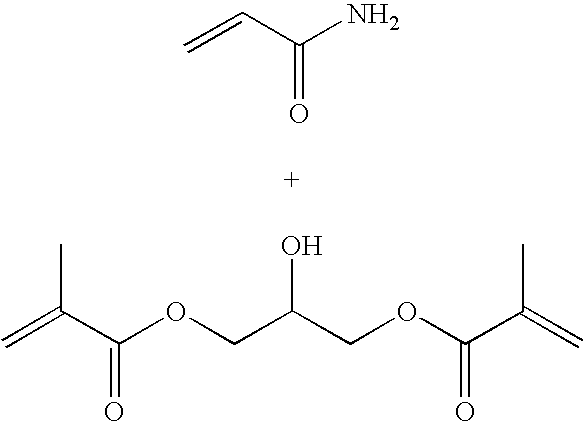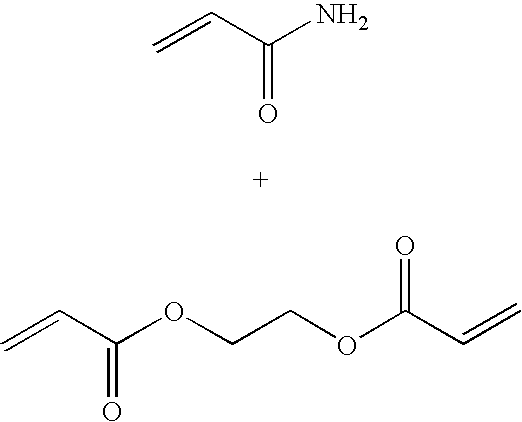Degradable nanoparticles
a nanoparticle and polymer technology, applied in the field of polymer nanoparticles, can solve the problems of not biodegradable cross-linking agents, few degradable nanoparticles composed of well-tolerated polymers, and few well-tolerated polymers, and achieve the effect of modulating the release rate of encapsulated drugs
- Summary
- Abstract
- Description
- Claims
- Application Information
AI Technical Summary
Benefits of technology
Problems solved by technology
Method used
Image
Examples
example 2
Synthesis of Amine Functionalized Degradable Nanoparticles.
[0083] The synthesis is on a 4 g scale and it can be extended to kilogram level.
[0084] The monomer solution was prepared by adding acrylamide (2.4 g), N-(3-aminopropyl)-methacrylamide hydrochloride (0.4 g) and glycerol(bis) acrylate (1.06 g) to sodium phosphate buffer (8 ml, 10 mM, pH 7.3). The slightly turbid mixture was sonicated for 10 min and added to a solution containing AOT (6.4 g) and Brij 30 (12.8 ml) in argon purged hexanes (180 mL). After a 10 min stirring at ambient temperature, the polymerization reaction was initiated by treating with a freshly prepared aqueous ammonium per sulfate (130 μl, 10%) and TEMED (170 μl). The reaction mixture was stirred over night under an argon atmosphere.
[0085] Hexane was removed under reduced pressure and the residue was treated with ethanol (150 ml). The precipitated nanoparticle solution was transferred into an amicon stirred cell (200 ml) equipped with a 500 KDa Biomax fil...
example 3
Synthesis of Nanoparticles Encapsulating Super Paramagnetic Iron Oxide (SPIO).
[0087] The following synthesis is on a 2 g scale and it can be extended from multi gram to kilogram level.
[0088] A 20 ml glass vial was charged with acrylamide (1.2 g) and 2 ml of sodium phosphate buffer (10 mM, pH 7.3). The suspension was sonicated for 2 min to obtain a clear solution. Glycerol(bis)acrylate (0.53 g) was added to the reaction mixture and sonicated for an additional 5 min. The resulting slightly turbid monomer solution was treated with Iron oxide solution (180 mg) and the deep dark mixture was sonicated for 10 min.
[0089] A 250 ml round bottom flask equipped with a mechanical stirrer was charged with AOT (3.2 g) and Brij 30 (6.4 ml) in argon purged hexanes (90 ml). The clear solution was treated with the above iron oxide monomer solution with stirring. After a 10 min mechanical stirring (high speed) under an argon blanket at room temperature, the polymerization was initiated by treating ...
example 4
Synthesis of Nanoparticles Encapsulating Ruthenium Dye.
[0092] The following synthesis is on a 2 g scale and it can be extended from multi gram to kilogram level.
[0093] A clean 20 ml glass vial was charged with acrylamide (1.2 g) and 4 ml of sodium phosphate buffer (10 mM, pH 7.3). The suspension was sonicated for 2 min to obtain a clear solution. Glycerol(bis)acrylate (0.53 g) was added to the reaction mixture and sonicated for an additional 5 min. Ruthenium dye (5 mg, Ru(dpp)(SO3Na)2)3 disulfonated 4,7-diphenyl-1,10-phenantroline Ruthenium) was added and the mixture was sonicated for an additional 5 min. The resulting slightly turbid monomer solution was added to a 250 ml round bottom flask containing an argon-purged, well stirred solution of dioctyl sulfosuccinate (3.2 g) and Brij 30 (6.4 ml) in hexanes (90 ml). After a 10 min stirring under an argon blanket at room temperature, the reaction mixture was treated with freshly prepared aqueous ammonium per sulfate (65 μl, 10%) and...
PUM
| Property | Measurement | Unit |
|---|---|---|
| diameter | aaaaa | aaaaa |
| diameter | aaaaa | aaaaa |
| diameter | aaaaa | aaaaa |
Abstract
Description
Claims
Application Information
 Login to View More
Login to View More - R&D
- Intellectual Property
- Life Sciences
- Materials
- Tech Scout
- Unparalleled Data Quality
- Higher Quality Content
- 60% Fewer Hallucinations
Browse by: Latest US Patents, China's latest patents, Technical Efficacy Thesaurus, Application Domain, Technology Topic, Popular Technical Reports.
© 2025 PatSnap. All rights reserved.Legal|Privacy policy|Modern Slavery Act Transparency Statement|Sitemap|About US| Contact US: help@patsnap.com



